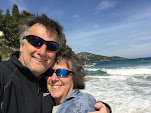
Preamble… Before we start… I will tell you that I have converted my KO Esprit Vantage II (Type R) to Spektrum DSM. This is a one-way street, you cannot convert back again, so I had to be sure. Two meetings later and I am very happy…. Here is the longer version.

Well I waited and waited:
On the surface it was an irresistible proposition: No more radio interference, no chance of a frequency clash. No need to carry multiple crystals, no queuing during practice sessions, waiting for a peg. No one from the next heat can turn on and wreck the end of your run…..
But you see, I am a cynic. There had to be a catch:
Well, I saw one catch… cars turning themselves off after collisions. Spektrum themselves document the issues here
http://www.spektrumrc.com/Articles/HobbyWire.aspx
I saw it for myself in the UK with the 2005 “early adopters” and even at the 2006 12th scale Euros back in March 2006 with some cars taking a hit and needing to be turned off and on again to get going again… why would I want that?
But they fixed it. A hardware antenna problem on the transmitter module was identified and a software update followed. Then came the Pro Series with reduced latency and I judged it was time for even old gits (like me!) and late adaptors to take the floor……
I like my Sticks
Since my return to RC racing in 1999 as a more “mature racer”, I bought a KO Vantage (later upgraded to a Vantage II Type R). I need sticks! I like this thing and
I had no desire to loose a friend in the pursuit of advancement.
My path into the world of 2.4Ghz RC was therefore to convert my KO Vantage to Spectrum DSM Pro Series
The One Way Street
The KO Vantage transmitter can be converted to accept the standard DSM transmitter module. This is a conversion (in the UK) that has to be carried out by Helger Racing http://www.helgerracing.com/
The conversion involves the permanent removal of the KO crystal module and it’s internal connectors within the transmitter. You get the module PCB back but the case becomes a blanking plate. The innards are coming home in a plastic bag!

A small backplane connector is installed in the TX and a neat hole is cut into the back of the rear case to take the Spektrum DSM Module.
The transmitter antenna is removed and the resulting hole finished off with a neat blanking plug.

… and that’s it.
Sell all of your old KO receivers because they are now unusable with your converted tranny.
Products
I purchased the SPM1013 Pro package for KO radios consisting of the SM1001 TX Module and Pro Receiver SR3001. The cost of this package in the UK is £165. In addition to this, the cost of the conversion to the Vantage is £47.50.
I also purchased the micro receiver (SR3500), which retails at £65. This goes into my 1/12th car (oh my gosh its small!) and the SR3001 has become the spare or for a second car.
Size Matters

As my comparison photo shows, the Standard SR3001 RX is just a little larger than the KO-301F RX and the micro SR3500 unit is even smaller than the tiny KO-302F. Any of these RX units will fit into a 1/12th car but the SR3500 is something special!

Voltage
The Spectrum system will work right down to 3.2V so even 4 cell 1/12th racing should be no problem.
I prefer to use a 5 cell RX pack in my 1/12th for three reasons:
(1.) I like the extra servo speed
(2.)We have found the brushless system can divert power from the motor at the end of a run with the 4 cell configuration making the car feel soft when in fact there is power to spare.
(3.) We have seen personal transponder counting errors if the loop is placed in a position where 4 cell cars “power up” due to voltage dip.
My choice of running the RX pack hence has nothing to do with the Spektrum system.
In Use

I have used the system at three events now without fault.
In the light of personal transponders, the old hand out units seem obviously outdated, who would want to go back? I think the Spektrum DSM system will do the same thing for crystal radio systems.
Advantages
I don’t have to think about turning on, no one can clash with me and I cannot interfere with anyone else.
It’s fast. I cannot tell the difference. The issue of speed seems irrelevant to me.
Relax between the qualifiers and the finals… there will be no crystals to change!
Apparently it will not glitch and I have no evidence to the contrary.
The SR3500 receiver is very very small. As is its antenna wire.
Disadvantages
I don’t like the balance change to the Vantage transmitter with the antenna missing. I will be fixing it back and running the system with a “dummy” aerial up.
I think it’s a bit expensive! But I’m worth it ;-)
www.spektrumrc.com will tell you all you need to know about the system
www.helgerracing.com for the UK distributer of KO Propo and Spektrum





















